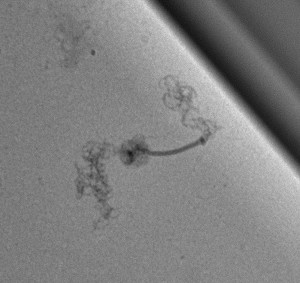Throughout the Fall 2014 semester, the H-SC Molecular and Cellular Biology class worked to discover and characterize new phages that infect bacteria of the genus Bacillus as part of their original research in conjunction with the Howard Hughes Medical Institute (HHMI) SEA-PHAGES project. As part of this project, representatives of the class travelled to the University of Mary Washington, a SEA-PHAGES collaborator, to get pictures of their phages on their electron microscope. The pictures provided the students invaluable insight on the nature of their new discoveries, which have been catalogued with the central SEA-PHAGES lab at the University of Pittsburgh as part of their ongoing work on viral evolution.

“HSCtrl”, as discovered by Chris Ferrante ’15. Note the DNA spilling out from the capsid head of this sample.
Phage “Archie14”, as discovered by Stephen Woodall ’15, has been sequenced by the University of Pittsburgh and returned to H-SC for analysis. The next step in the research will be done by students interested in bioinformatics who will thoroughly examine Archie14’s genome for particular genetic features that make it unique from other phages. This project, along with projects in several other H-SC biology classes, is part of an effort in the department to make research a central part of the H-SC biology experience.

